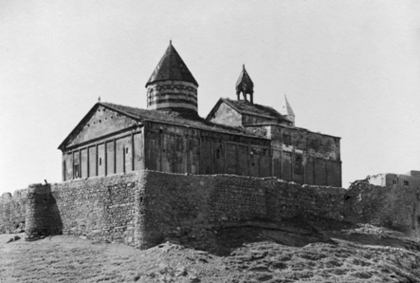 St. Bartholomew
St. Bartholomew  St. Thaddeus
St. Thaddeus Pre-301
According to the Holy Tradition of the Armenian Church, the first seeds of Christianity were sown on the Armenian land at the time of the apostles. In the 1st century, both external and internal conditions were favourable for preaching Christianity in Armenia. Christianity also spread to the countries close to Armenia: Cappadocia, Osrohene, and Adiabene. Armenia’s commercial, political, and cultural relations with those countries made the advance of Christianity easier. Christianity was first introduced in Lesser Armenia and then expanded to Greater Armenia.
A series of historical testimonies in Armenian, Syriac, Greek and Latin, confirm the fact that the Apostles Saints Thaddeus and Bartholomew preached Christianity in Armenia, thus becoming the founders of the Armenian Church. An important prerequisite for the propagation of Christianity was the existence of a Jewish Diaspora in Armenia. It is known that the first preachers of Christianity usually began their activity in those communities. The Apostle St. Thaddeus, arriving in Edessa, resided at the house of a Jewish nobleman Tubia. At that time, Jewish communities existed in the principal cities of Armenia, in Tigranokert, Artashat, Vagharshapat, and Zarehavan.
After the Ascension of Christ, St. Thaddeus arrived in Edessa in 44 A.D. and cured King Abgar of Osrohene from leprosy. After preaching throughout lesser Armenia, he ordained Bishop Addeh to serve in his absence as locum tenens of the Church and left for Greater Armenia to preach the Word of God. According to the Holy Tradition, Bishop Addeh was a royal robe maker by trade, and the maker of mitres to the Edessan court. After St. Thaddeus departed, King Abgar’s son, who ascended the throne after his father’s death, re-established paganism. He demanded that Bishop Addeh make him a mitre. Bishop Addeh refused, and soon after was martyred. He is remembered as St. Addeh.
St. Thaddeus continued his preaching in Greater Armenia, and converted many followers, including Princess Sandukht, the daughter of King Sanatruk of Shavarshan, in the province of Artaz.
When the king learned of his daughter’s conversion, he used every means possible to convince her to return to paganism. Exhausting all efforts, the king finally offered his daughter a choice between Christianity and death or paganism and her crown. Remaining steadfast in her faith, she chose death, and became the first woman saint of the Armenian Church. In addition to her martyrdom, St. Sandukht is also remembered for her efforts in converting others.
By the order of King Sanatruk St. Thaddeus, along with his converts, was martyred soon after the princess in 66 A.D., for preaching Christianity. Before he was killed, St. Thaddeus secretly buried the remains of St. Sandukht. A monk named Giragos discovered the remains of St. Thaddeus and St. Sandukht near a field of Shavarshan, sometime in the 4th or early 5th century.
St. Bartholomew arrived in Armenia after preaching in Persia, during the 29th year of King Sanatruk’s reign. Here he converted the king’s sister Voguhy and many nobles. He also was martyred by King Sanatruk’s orders in 68 A.D., in the city of Arebanos, which was situated between the Lakes Van and Urmia.
Near the end of the 1st and the beginning of the 2nd centuries, members of the Voskyan and Sukiasian families continued the preaching of St. Thaddeus. A portion of the history about the martyrdom of these Saints has been preserved until today. The author of the historic account is the historian Tatian (2nd century), who was well acquainted with all the stories of the apostles and the first Christian preachers. His references on the preachers and martyrs in Armenia are of great value.
Official Adoption


